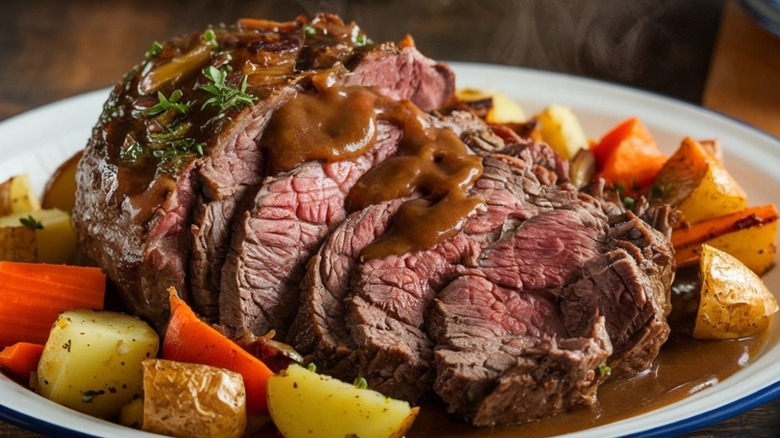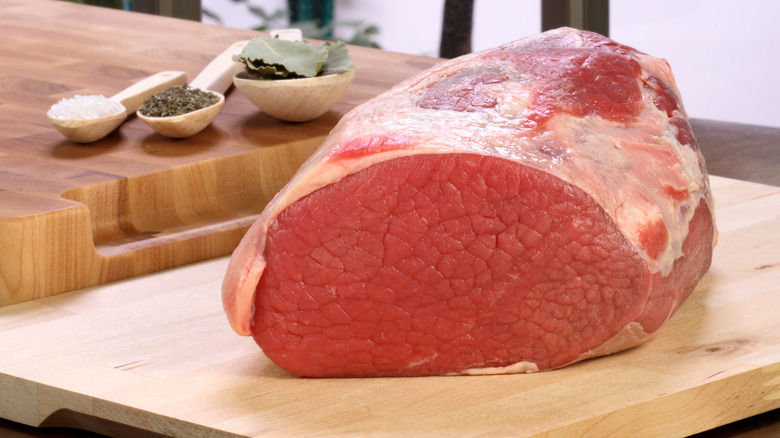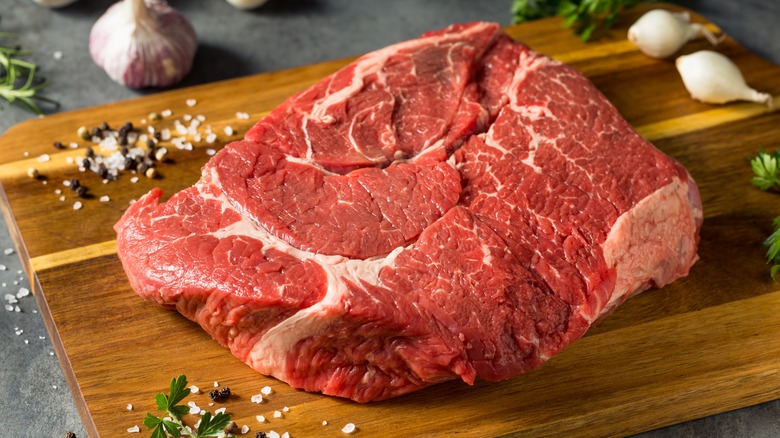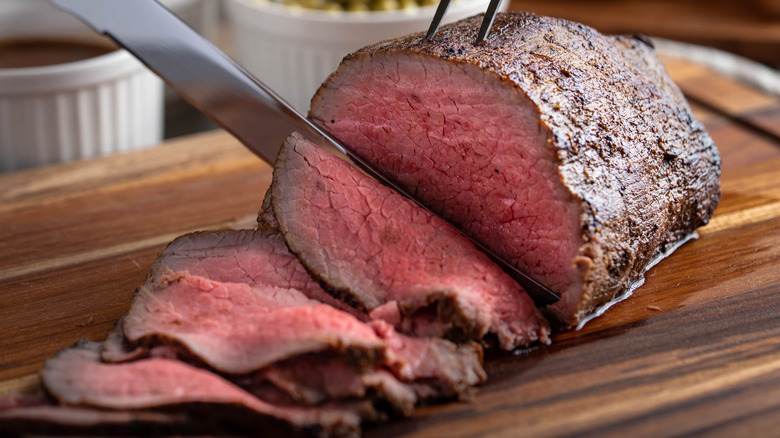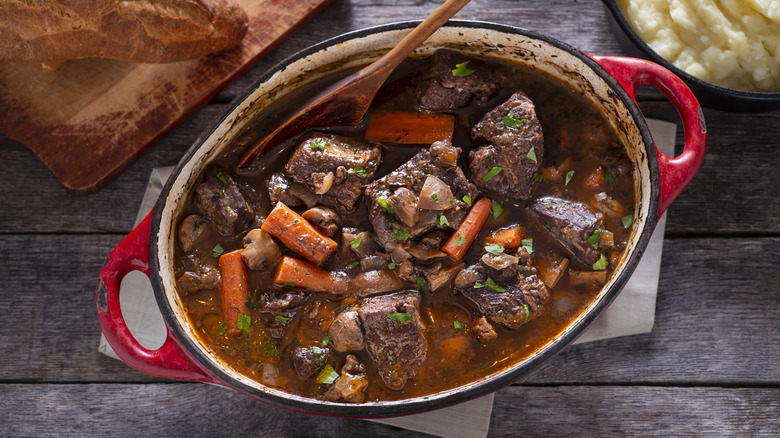Rump Roast Vs Chuck Roast: What's The Difference?
So your party is fast approaching and you've promised a crowd-pleasing beef dinner, and now you're at the grocery store staring at a rump roast and chuck roast in either hand. You figured this was going to be pretty easy, even though there are a lot of cuts of beef steaks to consider. People might get picky about whether they prefer a New York strip or T-bone steak, but when you are sticking a big round hunk of beef in a slow cooker, nobody is that concerned over the name of what you used. Still, you don't want to mess this up. You know you need something that is going to turn out fork tender and flavorful, and while these two options look very similar, they seem just different enough to give you pause.
What really is the difference between these two roast meats? Well, the good news is that chuck and rump are two of the best cuts of beef to use in slow-cooked dishes, but they have enough separating them to warrant slightly different treatment. They are both large, tough cuts, but they come from different sections of the cow. Rump roast and chuck roast are each pretty lean, but you'll notice that chuck roast does have more noticeable fat than rump roast does, which is going to affect how you cook it. They are both pretty affordable, too. While they will work in similar dishes, chuck and rump have some unique roles that they are each better suited to as well. So, which do you choose?
What is rump roast?
Rump roast is one of the more literal names in beef, as it comes from the top hindquarters of the cow. The larger section is referred to as the round, which covers the whole area around the back legs of the cow. The texture of beef cuts is generally determined by how much work that section of the cow is doing, and the back legs are doing a lot, making most of the cuts from this area tough and lean. The upside is that hard-working areas are also quite flavorful. Rump roast is a triangular cut from the top section of the round. Most cows will produce three or four rump roasts, each weighing between three and four pounds.
Rump roast's toughness and lack of fat make it a less desirable cut of beef, and therefore it's even cheaper than other roasts like chuck. It is, however, decently tender compared to some other roast cuts. In the typically confusing world of beef terminology, you may also see it referred to by other names like bottom round roast or round tip roast. While not as versatile as other cuts of beef, there are a few uses that rump roast is popular for. Pot roast is commonly made using rump, and it's also good for making roast beef, like that used in this roast beef po'boy sandwich, where the slow cooking and thin slicing help mitigate its leanness.
What is chuck roast?
Chuck roast is a large cut that comes from the chuck primal cut of beef. The chuck is kind of a mirror image of the round, centered around the neck, shoulder, and upper front legs of the cow. That means that cuts from the chuck have a similarly tough and lean character as those from the round. However, beef chuck has more of a mixture of connective tissue and bones, making it challenging to cook. This also means that while lean, chuck roast and other chuck cuts do have a higher level of fat than beef from the round. The crisscrossing scramble of meat and tissue means that much of the chuck is often made into ground beef, but the rest of the primal is usually made into chuck roasts or similar cuts.
Beef from the chuck is considered richly flavored and beefy. Chuck roast is located at the top of the chuck, which is around the cow's shoulders. Like rump roast, it is a very heavily worked section of beef, and thus tough before it's cooked. Outside of roasts, you are probably most familiar with ground chuck, as this is one of the cuts most popular for ground beef because it features a strong flavor and decent amount of fat. Chuck roast is usually the top choice for pot roast, and may even be labeled that on the shelf. Unlike rump roasts, the more tender parts of chuck roasts may also be broken down into individual steaks, which are called flat-iron steaks.
Rump roast is an extra lean cut of beef that must be slow cooked
While both rump roast and chuck are classified as lean cuts, rump roast is still noticeably leaner. In fact, round cuts produce the leanest cuts of steak and roasts of all sections, and rump roast is actually considered one of the few extra-lean cuts. There is almost no visible marbling on a rump roast, and it can be as tough as leather if not cooked correctly. There's an ideal way to cook every cut of beef, and the only way to make rump work is to slow cook it at low temperatures for hours, which breaks down the connective tissue and softens the meat. It can then be sliced or shredded like pulled pork.
Chuck roast is also lean, but has enough fat marbling to give it a richer flavor and make it more juicy as it cooks. It must also be slow-cooked like rump roast. But once cooked, it will soften beautifully, and the rendered fat will contribute a great flavor and texture to the meat and any juices it's cooked with. Because of this, it is less susceptible to drying out than rump roast. It's more about giving a chuck roast the time it needs than anything else.
Chuck roast is better for stews while rump roast excels for sandwiches
Chuck roast and rump roast are similar enough that they can both be used in many of the same roast recipes, including pot roast, but there is enough of a difference in the fat content and texture to make chuck roast the better choice for many slow-cooked dishes. Chuck roast will be best when a recipe benefits from the added richness and juiciness it brings. That's why it is usually preferred over rump for pot roasts, like this super tender herb and fig pot roast recipe, as it will create a more succulent sauce and melt-in-your-mouth feel to the meat. For the same reason, it's also a better choice when cubing meat for stews where the rendered fat helps flavor the broth and give it an appealing sheen. This also includes stewy shredded beef dishes like birria and barbacoa.
Rump roast is better when you want less fat, especially in dishes where you might be adding a separate gravy or sauce to compensate for its dryness. It's good for sliced roast beef dinners or sandwiches because the meat itself is more tender, and if slow cooked it won't be studded with any chewy hunks of fat or tissue. It should also shred well, making it an economical choice for tacos or large servings of pulled beef dishes like Cuban ropa vieja. While it's not an ideal piece, rump roast is still flavorful, and with patience can be just as delicious as many beef cuts at a real budget price.
